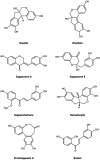Protective Effects of Caesalpinia sappan Linn. and Its Bioactive Compounds on Cardiovascular Organs
- PMID: 34603037
- PMCID: PMC8479160
- DOI: 10.3389/fphar.2021.725745
Protective Effects of Caesalpinia sappan Linn. and Its Bioactive Compounds on Cardiovascular Organs
Abstract
Cardiovascular diseases are the leading cause of death worldwide. The long-term aim of cardiovascular disease therapy is to reduce the mortality rate and decelerate the progression of cardiovascular organ damage. Current therapies focus on recovering heart function and reducing risk factors such as hyperglycemia and dyslipidemia. However, oxidative stress and inflammation are important causes of further damage to cardiovascular organs. Caesalpinia sappan Linn. (Fabaceae), a flowering tree native to tropical Asia, has antioxidant and anti-inflammatory properties. It is used as a natural dye to color food and beverages and as a traditional treatment for diarrhea, diabetes, and blood stasis. The phytochemical compounds in C. sappan, mainly the homoisoflavonoids brazilin, sappanone A, protosappanin, and hematoxylin, can potentially be used to protect cardiovascular organs. This review aims to provide updates on recent developments in research on C. sappan in relation to treatment of cardiovascular diseases. Many studies have reported protective effects of the plant's bioactive compounds that reduce cardiac damage and enhance vasorelaxation. For example, brazilin and sappanone A have an impact on molecular and cellular changes in cardiovascular disease pathogenesis, mainly by modulating oxidative, inflammatory, and apoptotic signaling pathways. Therefore, bioactive compounds of C. sappan have the potential to be developed as therapeutic agents to combat cardiovascular diseases like myocardial infarction and vascular disease. This review could help further the understanding of the possible modulatory role of the compounds in cardiovascular diseases, thereby facilitating future studies.
Keywords: Caesalpinia sappan; brazilein; brazilin; heart; ischemia/reperfusion injury; sappanone A; vascular; vasorelaxation.
Copyright © 2021 Syamsunarno, Safitri and Kamisah.
Conflict of interest statement
The authors declare that the research was conducted in the absence of any commercial or financial relationships that could be construed as a potential conflict of interest.
Figures



Similar articles
-
A Comprehensive Review on Bioactive Compounds Found in Caesalpinia sappan.Molecules. 2023 Aug 25;28(17):6247. doi: 10.3390/molecules28176247. Molecules. 2023. PMID: 37687076 Free PMC article. Review.
-
Iron chelating, antioxidant, and anti-inflammatory properties of brazilin from Caesalpinia sappan Linn.Heliyon. 2024 Sep 21;10(19):e38213. doi: 10.1016/j.heliyon.2024.e38213. eCollection 2024 Oct 15. Heliyon. 2024. PMID: 39397930 Free PMC article.
-
Brazilin and Caesalpinia sappan L. extract protect epidermal keratinocytes from oxidative stress by inducing the expression of GPX7.Chin J Nat Med. 2018 Mar;16(3):203-209. doi: 10.1016/S1875-5364(18)30048-7. Chin J Nat Med. 2018. PMID: 29576056
-
An LC/MS/MS method for simultaneous quantitation of two homoisoflavones: protosappanin B and brazilin with hypoglycemic activity in rat plasma and its application to a comparative pharmacokinetic study in normal and streptozotocin-treated rats.J Ethnopharmacol. 2013 Jul 9;148(2):682-90. doi: 10.1016/j.jep.2013.05.029. Epub 2013 May 21. J Ethnopharmacol. 2013. PMID: 23707335
-
Unlocking the therapeutic mechanism of Caesalpinia sappan: a comprehensive review of its antioxidant and anti-cancer properties, ethnopharmacology, and phytochemistry.Front Pharmacol. 2025 Jan 7;15:1514573. doi: 10.3389/fphar.2024.1514573. eCollection 2024. Front Pharmacol. 2025. PMID: 39840104 Free PMC article. Review.
Cited by
-
Caesalpinia sappan L. ethyl acetate extract regulated angiogenesis in atherosclerosis by modulating the miR-126/VEGF signalling pathway.Heliyon. 2025 Jan 22;11(3):e42159. doi: 10.1016/j.heliyon.2025.e42159. eCollection 2025 Feb 15. Heliyon. 2025. PMID: 39931479 Free PMC article.
-
Role of Trimetazidine in Ameliorating Endothelial Dysfunction: A Review.Pharmaceuticals (Basel). 2024 Apr 5;17(4):464. doi: 10.3390/ph17040464. Pharmaceuticals (Basel). 2024. PMID: 38675424 Free PMC article. Review.
-
Antiplatelet Effects of a Combination of Sappan Wood (Caesalpinia sappan L.) and Red Ginger (Zingiber officinale var. Rubrum) Extracts in a High-Fat Diet-Induced Rat Model.Adv Pharmacol Pharm Sci. 2024 Dec 20;2024:5543717. doi: 10.1155/adpp/5543717. eCollection 2024. Adv Pharmacol Pharm Sci. 2024. PMID: 39734397 Free PMC article.
-
Cell Staining Microgels Derived from a Natural Phenolic Dye: Hematoxylin Has Intriguing Biomedical Potential.Pharmaceutics. 2024 Jan 22;16(1):147. doi: 10.3390/pharmaceutics16010147. Pharmaceutics. 2024. PMID: 38276517 Free PMC article.
-
Cardioprotective Properties of Kaempferol: A Review.Plants (Basel). 2023 May 24;12(11):2096. doi: 10.3390/plants12112096. Plants (Basel). 2023. PMID: 37299076 Free PMC article. Review.
References
-
- Badami S., Moorkoth S., B S. (2004). Caesalpinia Sappan – A Medicinal and Dye Yielding Plant. Indian J. Nat. Prod. Resour. 3 (2), 75–82.
Publication types
LinkOut - more resources
Full Text Sources

